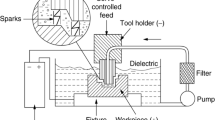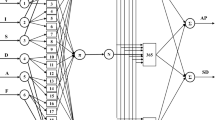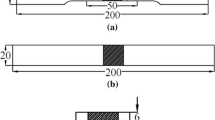Abstract
High power density welding technologies are widely used nowadays in various fields of engineering. However, a computationally efficient and quick predictive tool to select the operating parameters in order to achieve the specified weld attribute is conspicuously missing in the literature. In the present study, a computationally efficient inverse model has been developed using artificial neural networks (ANNs). These ANNs have been trained with the outputs of physics-based phenomenological model using back-propagation (BP) algorithm, genetic algorithm (GA), particle swarm optimization (PSO) algorithm and bat algorithm (BA) separately to develop both the forward and reverse models. Unlike data driven ANN model, such approach is unique and yet based on science. Power, welding speed, beam radius and power distribution factor have been considered as input process parameters, and four weld attributes, such as length of the pool, depth of penetration of the pool, half-width of the pool and cooling time are treated as the responses. The predicted outputs of both the forward and reverse models are found to be in good agreement with the experimental results. The novelty of this study lies with the development and testing of five neural network-based approaches for carrying out both forward and reverse mappings of the electron beam welding process.




















Similar content being viewed by others
References
David SA, DebRoy T, Vitek JM (1994) Phenomenological modeling of fusion welding processes. MRS Bull 19:29–35. https://doi.org/10.1017/S0883769400038835
Mundra K, DebRoy T, Babu SS et al (1995) Towards predicting weld metal microstructure from fundamentals of transport phenomena. In: Proceedings of 7th conference on modeling of casting, welding and advanced solidification processes. London
Koleva E, Mladenov G, Vutova K (1999) Calculation of weld parameters and thermal efficiency in electron beam welding. Vacuum 53:67–70. https://doi.org/10.1016/S0042-207X(98)00393-5
He X, Fuerschbach PW, DebRoy T (2003) Heat transfer and fluid flow during laser spot welding of 304 stainless steel. J Phys D Appl Phys 36:1388–1398. https://doi.org/10.1088/0022-3727/36/12/306
He X, Elmer JW, Debroy T (2005) Heat transfer and fluid flow in laser microwelding. J Appl Phys 97:084909. https://doi.org/10.1063/1.1873032
Roy GG, Elmer JW, DebRoy T (2006) Mathematical modeling of heat transfer, fluid flow, and solidification during linear welding with a pulsed laser beam. J Appl Phys 100:034903. https://doi.org/10.1063/1.2214392
Rai R, Roy GG, Debroy T (2007) A computationally efficient model of convective heat transfer and solidification characteristics during keyhole mode laser welding. J Appl Phys 101:054909. https://doi.org/10.1063/1.2537587
Rai R, Elmer JW, Palmer TA, DebRoy T (2007) Heat transfer and fluid flow during keyhole mode laser welding of tantalum, Ti–6Al–4V, 304L stainless steel and vanadium. J Phys D Appl Phys 40:5753–5766. https://doi.org/10.1088/0022-3727/40/18/037
Rai R, Palmer TA, Elmer JW, Debroy T (2009) Heat transfer and fluid flow during electron beam welding of 304L stainless steel alloy. Weld J 88:54–61
Wang YJ, Guan YJ, Fu PF et al (2008) Study on shape factor of the fusion-solidification zone of electron beam weld. China Weld 17:62–67
Poorhaydari K, Patchett BM, Ivey DG (2005) Estimation of cooling rate in the welding of plates with intermediate thickness. Weld J 84:149–155
Petrov P (2010) Optimization of carbon steel electron-beam hardening. J Phys Conf Ser 223:012029. https://doi.org/10.1088/1742-6596/223/1/012029
Pirinen M (2013) The effects of welding heat input on the usability of high strength steels in welded structures. Lappeenranta University of Technology, Lappeenranta
Doong JL, Wu CS, Hwang JR (1991) Infrared Temperature Sensing of Laser Welding. Int J Mach Tools Manuf 31:607–616. https://doi.org/10.1016/0890-6955(91)90040-A
Zambon A, Bonollo F (1994) Rapid solidification in laser welding of stainless steels. Mater Sci Eng A 178:203–207. https://doi.org/10.1016/0921-5093(94)90544-4
Walsh CA (2002) Laser welding - literature review. Materials Science and Metallurgy Department, University of Cambridge, England, from http:www.msm.cam.ac.uk/phase-trans/2011/laser_Walsh_review.pdf, accessed 8 June 2016 21
Inoue T, Tanabe K, Ohara M et al (1993) Development of heavy steel plates with excellent electron beam weldability. Nippon Steel Tech Rep 58:17–25
Bag S, De A, DebRoy T (2009) A genetic algorithm-assisted inverse convective heat transfer model for tailoring weld geometry. Mater Manuf Process 24:384–397. https://doi.org/10.1080/10426910802679915
Manvatkar VD, Arora A, De A, Debroy T (2012) Neural network models of peak temperature, torque, traverse force, bending stress and maximum shear stress during friction stir welding. Sci Technol Weld Join 17:460–466. https://doi.org/10.1179/1362171812Y.0000000035
Mishra S, Debroy T (2005) A heat-transfer and fluid-flow-based model to obtain a specific weld geometry using various combinations of welding variables. J Appl Phys 98:044902. https://doi.org/10.1063/1.2001153
Andersen K, Cook GE, Karsai G, Ramaswamy K (1990) Artificial neural networks applied to arc welding process modeling and control. IEEE Trans Ind Appl 26:824–830. https://doi.org/10.1109/28.60056
Karsai G, Andersen K, Cook GE, Barnett JR (1992) Neural network methods for the modeling and control of welding processes. J Intell Manuf 3:229–235. https://doi.org/10.1007/BF01473900
Lim T G, Cho HS (1993) Estimation of weld pool sizes in GMA welding process using neural networks. Proc Inst Mech Eng Part I. J Syst Control Eng 207:15–26. https://doi.org/10.1243/PIME_PROC_1993_207_311_02
Dutta P, Pratihar DK (2007) Modeling of TIG welding process using conventional regression analysis and neural network-based approaches. J Mater Process Technol 184:56–68. https://doi.org/10.1016/j.jmatprotec.2006.11.004
Chokkalingham S, Chandrasekhar N, Vasudevan M (2010) Artificial neural network modeling for estimating the depth of penetration and weld bead width from the infra red thermal image of the weld pool during A-TIG welding. Simulated Evol Learn 6457:270–278. https://doi.org/10.1007/978-3-642-17298-4_28
Reddy DYA, Pratihar DK (2011) Neural network-based expert systems for predictions of temperature distributions in electron beam welding process. Int J Adv Manuf Technol 55:535–548. https://doi.org/10.1007/s00170-010-3104-6
Jha MN, Pratihar DK, Dey V et al (2011) Study on electron beam butt welding of austenitic stainless steel 304 plates and its input-output modelling using neural networks. Proc Inst Mech Eng Part B-J Eng Manuf 225:2051–2070. https://doi.org/10.1177/0954405411404856
Khorram A, Ghoreishi M, Yazdi MRS, Moradi M (2011) Optimization of bead geometry in CO2 laser welding of Ti 6Al 4V using response surface methodology. Engineering 03:708–712. https://doi.org/10.4236/eng.2011.37084
Srivastava S, Garg RK (2017) Process parameter optimization of gas metal arc welding on IS:2062 mild steel using response surface methodology. J Manuf Process 25:296–305. https://doi.org/10.1016/j.jmapro.2016.12.016
Ronda J, Siwek A (2011) Modelling of laser welding process in the phase of keyhole formation. Arch Civ Mech Eng 11:739–752. https://doi.org/10.1016/S1644-9665(11)60113-7
Gao X D, Zhang Y X (2014) Prediction model of weld width during high-power disk laser welding of 304 austenitic stainless steel. Int J Precis Eng Manuf 15:399–405. https://doi.org/10.1007/s12541-014-0350-9
Praga-Alejo RJ, Torres-Treviño LM, González-González D S et al (2012) Analysis and evaluation in a welding process applying a redesigned radial basis function. Expert Syst Appl 39:9669–9675. https://doi.org/10.1016/j.eswa.2012.02.154
Torres-Treviño LM, Reyes-Valdes FA, López V, Praga-Alejo R (2011) Multi-objective optimization of a welding process by the estimation of the Pareto optimal set. Expert Syst Appl 38:8045–8053. https://doi.org/10.1016/j.eswa.2010.12.139
Buffa G, Fratini L, Micari F (2012) Mechanical and microstructural properties prediction by artificial neural networks in FSW processes of dual phase titanium alloys. J Manuf Process 14:289–296. https://doi.org/10.1016/j.jmapro.2011.10.007
Lim C, Gweon C, Advanced K, Kaist T (1999) In-process joint strength estimation in pulsed laser spot welding using artificial neural networks. J Manuf Process 1:31–42
Kennedy J, Eberhart R (1995) Particle swarm optimization. In: Neural networks, 1995 proceedings, IEEE international conference, vol 4, pp 1942–1948. https://doi.org/10.1109/ICNN.1995.488968
Jha MN, Pratihar DK, Bapat AV et al (2014) Knowledge-based systems using neural networks for electron beam welding process of reactive material (Zircaloy-4). J Intell Manuf 25:1315–1333. https://doi.org/10.1007/s10845-013-0732-3
Elman JL (1990) Finding structure in time. Cogn Sci 14:179–211. https://doi.org/10.1207/s15516709cog1402_1
Ge HW, Liang YC, Marchese M (2007) A modified particle swarm optimization-based dynamic recurrent neural network for identifying and controlling nonlinear systems. Comput Struct 85:1611–1622. https://doi.org/10.1016/j.compstruc.2007.03.001
Zhou C, Ding L Y, He R (2013) PSO-based Elman neural network model for predictive control of air chamber pressure in slurry shield tunneling under Yangtze River. Autom Constr 36:208–217. https://doi.org/10.1016/j.autcon.2013.03.001
Yang X et al (2010) A new metaheuristic bat-inspired algorithm. In: González J R (ed) International workshop on nature inspired cooperative strategies for optimization (NICSO 2010), Studies in computational intelligence. Springer, Berlin, pp 65–74
Khan K, Sahai A (2012) A Comparison of BA, GA, PSO, BP and LM for training feed forward neural networks in e-learning context. Int J Intell Syst Appl 4:23–29. https://doi.org/10.5815/ijisa.2012.07.03
Meng XB, Gao XZ, Liu Y, Zhang H (2015) A novel bat algorithm with habitat selection and Doppler effect in echoes for optimization. Expert Syst Appl 42:6350–6364. https://doi.org/10.1016/j.eswa.2015.04.026
Yang X-S (2014) Nature-inspired optimization algorithms, 1st edn. Elsevier, Waltham
Jaddi NS, Abdullah S, Hamdan AR (2015) Optimization of neural network model using modified bat-inspired algorithm. Appl Soft Comput J 37:71–86. https://doi.org/10.1016/j.asoc.2015.08.002
Heraguemi KE, Kamel N, Drias H (2016) Multi-swarm bat algorithm for association rule mining using multiple cooperative strategies. Appl Intell 45:1021–1033. https://doi.org/10.1007/s10489-016-0806-y
Elmer JW, Giedt WH, Eager TW (1990) The transition from shallow to deep penetration during electron beam welding. Weld J 69:167–176
Kar J, Mahanty S, Roy SK, Roy GG (2015) Estimation of average spot diameter and bead penetration using process model during electron beam welding of AISI 304 stainless steel. Trans Indian Inst Met 68:935–941. https://doi.org/10.1007/s12666-015-0529-5
Roy GG, Zhang Z, Mishra S et al (2002) Manual on a computer program to calculate fluid flow and heat transfer during fusion welding with free surface. Department of Materials Science and Engineering, Pennsylvania State University, University Park, Pennsylvania-16802
Schultz H (1993) Electron beam welding. Abington Publishing, Cambridge
Schiller S, Heisig U, Panzer S (1982) Electron beam technology. Wiley, Berlin
Datta S, Pratihar DK, Bandyopadhyay PP (2012) Modeling of input–output relationships for a plasma spray coating process using soft computing tools. Appl Soft Comput 12:3356–3368. https://doi.org/10.1016/j.asoc.2012.07.015
Pratihar DK (2015) Soft computing fundamentals and applications. Narosa Publishing House Pvt. Ltd, New Delhi
Mohanty S, Laldas CK, Roy GG (2012) A new model for keyhole mode laser welding using FLUENT. Trans Indian Inst Met 65:459–466. https://doi.org/10.1007/s12666-012-0151-8
Acknowledgements
The first author gratefully acknowledges the financial support of the Ministry of Human Resource Development (MHRD), Government of India, for carrying out this research.
Author information
Authors and Affiliations
Corresponding author
Rights and permissions
About this article
Cite this article
Das, D., Pratihar, D.K., Roy, G.G. et al. Phenomenological model-based study on electron beam welding process, and input-output modeling using neural networks trained by back-propagation algorithm, genetic algorithms, particle swarm optimization algorithm and bat algorithm. Appl Intell 48, 2698–2718 (2018). https://doi.org/10.1007/s10489-017-1101-2
Published:
Issue Date:
DOI: https://doi.org/10.1007/s10489-017-1101-2




